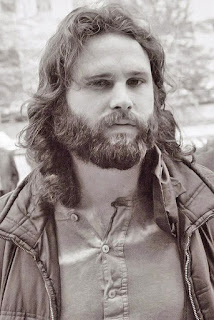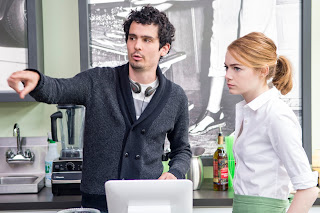Uncommon People: The Rise and Fall of the Rock Stars (2017) by David Hepworth: The age of the rock star, like the age of the cowboy, has passed. Like the cowboy, the idea of the rock star lives on in our imaginations. What did we see in them? Swagger. Recklessness. Sexual charisma. Damn-the-torpedoes self-belief. A certain way of carrying themselves. Talent we wished we had. What did we want of them? To be larger than life but also like us. To live out their songs. To stay young forever. No wonder many didn’t stay the course.
In Uncommon People, David Hepworth zeroes in on defining moments and turning points in the lives of forty rock stars from 1955 to 1995, taking us on a journey to burst a hundred myths and create a hundred more. As this tribe of uniquely motivated nobodies went about turning themselves into the ultimate somebodies, they also shaped us, our real lives and our fantasies. Uncommon People isn’t just their story. It’s ours as well. Author David Hepworth has been writing about, broadcasting about and speaking about music since the 70s. He was involved in the launch and/or editing of magazines like Smash Hits, Q, Mojo and The Word. He was one of the presenters of the BBC rock music programme Whistle Test. `I was born in 1950,' he says, `which means that in terms of music I have the winning ticket in the lottery of life'. Source: www.amazon.com
Rock stars are like the shooting stars that Jim Morrison once compared himself to. There is little doubt that Morrison was someone on a spiritual quest who had many valid reasons to question and even attack the status quo of his time. But his philosophy allowed his great intellect and wonderful gift for communication to become lost in a sea of anger, confusion, and self-abuse. Stardom may have validated Jim Morrison, but it also lit the fuse that proved to be his undoing. Money meant more booze, more drugs, and the one-night stands that he imagined were not only his due as a rock 'n' roll star, but his duty as a great romantic. There was a deep insecurity in him that could not be satisfied by fame or fortune. Morrison, as a human theatricon, offered an astonishing range of personal images: the masculine lover, the innocent poet, the vulgar hustler, a crazed demoniac or an angelic child. Morrison communicated a sensual dignity that was rarely seen in a rock star, blending rock music and theatrical drama. His image had been created amid the drab yellow walls of George Washington High School, refined at UCLA, and perfected on Sunset Strip.
As the pressures increased, he began to withdraw and become dissatisfied with The Doors, his audience, and himself. It is very common for people who acquire sudden wealth or fame to begin to question their own worth. There is an inner feeling that they're conning someone and they don't feel they deserve the money or the attention. Since Morrison never considered himself a singer these feelings must have been particularly strong, but it is doubtful that he would be able to acknowledge it. Instead, he continued on an ever-increasing self-destructive path as if to mock his strange glory. As far as his art was concerned, Morrison was often his own worst critic and he was beginning to have doubts. Sure, he was selling millions of records, but was he reaching anyone? Was anyone changing? People thought that rock 'n' roll could actually change the world.
The teen magazines saw him as a gift from the gods with the most photogenic face since Elvis Presley. The underground press locked on to his artistic and revolutionary side. No wonder the Establishment got worried. They were facing someone bigger than life. While Jim Morrison may have sought guidance from a shamanistic spirit, he opened himself to be used and abused by any spiritual energy that happened to come along. Jim Morrison became the first rock 'n' roll star to be arrested onstage during a live performance. In New Haven, the police overreacted not only in the shower stall, but in the concert hall. The L.A. Forum show on December 14 provided a fitting end to 1968 for The Doors. On the outside, the group was hailed as the biggest band in the country. The media called them "America's Rolling Stones." But on the inside Morrison was losing it. He was angry. Onstage in The Forum, he shouted: "Well, man, we can play music all night, but that's not what you really want, you want something more, something greater than you've ever seen, right?" "We want Mick Jagger," someone shouted. "Light My Fire," someone else said to laughter. The crowd began to giggle with nervous embarrassment. Most of them had no idea what Morrison was alluding to. They wanted more than a show, they wanted a spectacle. They wanted to watch him die.
As a poet, Morrison could hope for nothing akin to the adoration he was used to as a rock star. The best that could be hoped for was small-time sales and a few choice words from some stuffy critics that Morrison's very presence would offend. But though it was doomed from the start, Morrison would not let go of his desire to be accepted as a poet, so he went on to destroy his sex symbol image. For The Doors, the most immediate result of Miami was a nationwide ban. And the public was even worse. They were getting bored with what one critic called "the mechanical Mickey Mouse Theater of The Doors, its madman star and its constant travails." The Miami incident only sealed his fate in the minds of the public. He was a jerk, they reasoned, who thought he was so cool that he could get away with anything. They were no longer interested in breaking on through. And Morrison was caught on the other side alone. The Miami scandal was the logical culmination of everything Morrison had ever tried to say to the world. He had whispered, spoken, and sung his words many times before and few had listened. Now he shouted them one last time in desperation. Miami failed to make the audience look at themselves, it failed to make them learn about who they were, and it failed to make them cognizant of their own dark side in a way they could possibly accept. Sure, it made them afraid, but being afraid is not the same than understanding fear.
Though she may have had severe emotional problems of her own, there is little question that Pam Courson was the only real stabilizing force in Morrison's life. She was a glorious American archetype, the living image of Brian Wilson’s mythic California Girl, with the aura of a hippie princess or an ethereal wood sprite. Pamela was coveted by many of the musicians on the Los Angeles scene, and it has long been rumored that Neil Young wrote his epochal rock song “Cinnamon Girl” about her. Her physical delicacy and outward fragility, and her seeming vulnerability that demanded care and protection from any man who would be with her, belied Pamela Courson’s steely will, a rebel attitude, profoundly disturbed psyche, and dominating personality that would earn her many enemies in the Doors’ orbit. Those who really knew the couple understood that he would give her anything she wanted.―"Break on Through: The Life and Death of Jim Morrison" (2014) by James Riordan and Jerry Prochnicky
“I don't like categorizing stuff, but women's roles all through history have been to act as hierophant or someone who's guarded the secrets or guarded the temple. I'm a girl doing what guys usually did, the way that I look, the goals and kinds of things I want to help achieve through rock. It's more heroic stuff and heroic stuff has been traditionally male. I mean, Jim Morrison was trying to elevate the word; he was the poet in rock & roll before me. He was an academic poet. Lou Reed--another academic poet in rock.” ―Patti Smith
Paul Morrissey (The Smiths): Lou Reed seems unimpressed by applause, and lives a life detached from custom. His stare is cold and his songs are sometimes half-sung melodies of menace. He is the real thing. Examined ravenously like a museum exhibit, Lou Reed is evidently spiked to excess, and strangely loveable.
“They listen to the music of idiots and amuse themselves with the sordid miseries of their businesses. They are not made of the things of angels or of any higher outpost that humanity might aspire to. Your loathsome vomitous businessman king is of the lowest order, his advisors crumbling mockeries of education driven by avarice. My love, dress them in the suits of mockery, and in their advanced state of stupidity and senility, burn and destroy them, so their ashes might join the compost which they so much deserve.” ―The Raven (2003) by Lou Reed, based on the writings of Edgar Allan Poe. The Raven is a dreamlike evocation of Poe’s obsessions: loss, guilt, violence, self-destruction and bids for redemption.
“They listen to the music of idiots and amuse themselves with the sordid miseries of their businesses. They are not made of the things of angels or of any higher outpost that humanity might aspire to. Your loathsome vomitous businessman king is of the lowest order, his advisors crumbling mockeries of education driven by avarice. My love, dress them in the suits of mockery, and in their advanced state of stupidity and senility, burn and destroy them, so their ashes might join the compost which they so much deserve.” ―The Raven (2003) by Lou Reed, based on the writings of Edgar Allan Poe. The Raven is a dreamlike evocation of Poe’s obsessions: loss, guilt, violence, self-destruction and bids for redemption.































































